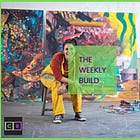How Diversity Grows Creative Businesses
It’s become politically charged in 2025. But for creative founders, diversity is a powerful way to grow your business.
Every creative founder eventually hits the same wall:
You can’t grow your business to its full potential by yourself.
You already know you need other people in your life. I hope you’ve also learned that the benefits of human connection—joy, enrichment, comfort—are heightened when you connect with people from different backgrounds who share similar values.
Something powerful happens when different lives lead to the same beliefs about what matters.
This hit me 20 years ago when I met Martin, a fellow father and lifelong learner who happened to grow up in Shanghai instead of Arkansas. My Southern roots would have me believe that any Buddhist member of the Chinese Communist Party is my adversary. It turns out Martin’s my friend.
I hope you’ve had that experience with people too. If you haven't, go chase it.
Why am I writing about personal connection in a business publication? Because the same magic happens in business.
And I mean exactly the same. Martin and I were coworkers who grew a business together in China.
That’s why diversity still matters to businesses in 2025, despite hostilities from the political right. It’s why companies like Costco and Delta Airlines are doubling down on their DEI policies despite political pressure.
I support diversity for moral reasons. But it’s also good for business. Diversity boosts innovation and problem solving. It makes every business stronger.
And for creative businesses, it’s the key to solving one of the hardest challenges you’ll face as your business matures: scaling it.
In today’s Workshop, I’ll show you why creative businesses are so hard to grow and how the right collaborators can help you break through.
I’ll also provide a tool to help you find collaborators who can help. Because they bring diversity to your business.
Why Are Creative Businesses Hard to Scale?
Let’s start by defining what it means to scale a business.
Limits to Growth
You probably understand business growth. You’re trying to grow revenue to support your livelihood.
Let’s say you’re a painter. You spend 40 hours on a painting and sell it to a customer for $2,000. You might say, “Hey, if I can sell 100 paintings to 100 customers a year, that’s $200,000 in revenue!” Sounds great, right?
But that’s hard to do. If each painting takes you 40 hours, you don’t have time in a year to create 100 paintings, run a business, and live your life. That’s 11 hours of painting every day without a single day off.
And what about the costs? If you spend $300 per painting on materials, that’s $30,000 per year you have to invest. If you sell at art fairs, and average 2 paintings sold at each fair, you’d need to attend 50 art fairs per year. At an average of $1,500 in booth fees, that’s another $75,000, for a total of $105,000 in annual costs. And these aren’t the only costs you need to consider.
That doesn’t mean you need $105,000 to get started. You could invest as you go, reinvesting profits from paintings you sell. But you might sell nothing at some fairs and 4 or 5 paintings at others. You need 3-6 months of your business costs in savings to help you weather the slow periods. Do you have $50,000 in the bank right now?
This illustrates the challenge of growing any creative business, regardless of your field.
Your business is highly dependent on your time and resources as a creator.
Scaling a Business
In my last Weekly Build, I gave advice on time management and how to be more productive with each hour you spend.
Better time management helps, but only a little. You’ll eventually hit a limit.
Scaling is different. Scaling breaks the link between business growth and the time or resources you have to invest in it. By scaling a business, you get more revenue with the same number of hours or dollars you invest.
There are lots different ways to break that link and scale your creative business. Today, I’ll focus on the most powerful: collaboration.
The Collaborative Model for Scaling
Creative collaboration isn’t a wild idea. You probably understand how collaboration leads to more creativity and better creative work. We see this all the time in music, film, and theater. People with different creative talents come together to create something not one of them could ever achieve alone.
But collaboration can also help you scale your business. Let’s see how.
Creative Outcomes & Pricing
The simplest way to scale your business is to increase prices. If you could double the price of that $2,000 painting to $4,000, you get double the revenue without increasing the number of creative hours or dollars you invest.
Collaboration enables that because of the phenomenon I just mentioned. When you collaborate with someone and push one another’s creative boundaries, your combined work is better than either of you could achieve alone. And you can charge more for it.
Working alone, you and another artist might each finish an average $2,000 painting in 40 hours. But when you collaborate, you might finish two phenomenal paintings, each worth $4,000. You’ve doubled the value of your combined creative output from $4,000 to $8,000. That’s what scaling looks like.
Talent Specialization
The second way collaboration helps with scaling is more businessy, but just as powerful. It’s based on the concept of talent specialization.
If you’re starting your business alone, you’re a jack of all trades. You’re a creator, a promoter, a chief financial officer, and an order fulfiller. Chances are, you’re not great at all of those roles.
Maybe you’re an amazing creator and promoter but the finance and fulfillment side of business drags you down. Finding a collaborator who’s great at finance and fulfillment would free up your time to focus on creation and promotion. Even better if creation and promotion are the exact talents they need to scale their own business.
Talent specialization helps the two of you achieve more together than you can alone. With the same amount of hours and resources you have to invest. This works because you both focus your time on work you’re uniquely qualified to do.
The Power of Diversity
Both of the ways that collaboration unlocks scale depend on diversity. The first one depends on creative diversity. The second, on talent diversity. And where do we get diversity in creativity and talent? From diverse lived experiences.
Think about it. If you clone yourself and partner with your clone, you don’t get either benefit. You don’t have new ideas pushing your work to new heights. And you don’t have someone with different talents to fill in your gaps.
So again, I agree with the moral argument for diversity in business. But the benefits of diversity are also practical. They’re measurable in dollars.
If you know someone who needs to hear this lesson, please share it with them!
Healthy Collaboration
So when you’re looking for a collaborator, look for someone different from you. Easy enough, right? But that’s not the whole story.
Not all differences are helpful and some actually hurt collaboration.
Like any human relationship, business partnerships have the potential to be unhealthy. Maybe you don’t click with some personality types, for example. But more than that, it’s hard to be successful with people who don’t believe in your mission or share your values.
Let’s go back to Martin and me growing our Chinese business. We had differences that made us complementary. He brought unique insights into the Chinese market and was fantastic at building relationships with Chinese customers. I brought strong strategy development and market experimentation skills. We accomplished more together than we could alone.
But we also had similarities that kept our relationship healthy, despite our very different backgrounds. We weren’t just growing a business, we were providing employment for a growing middle class in China. That was our shared mission. And we both valued people more than anything else, whether we were talking about employees, customers, or family. If either of us believed it was okay to hurt people in the name of profit, we would have fought and we would have failed.
So successful collaboration includes a mix of differences that complement each other and similarities that keep things healthy. To help you achieve that, I developed a tool to evaluate potential collaborations—The Healthy Collab Worksheet:
It guides you through a series of questions, with a place to take notes and score collaboration health across five dimensions:
Mission — Do you share the same mission or have missions that naturally coexist?
Values — Do your values align or do they conflict?
Strengths — Do they have strengths where you have weaknesses?
Roles & Boundaries — Do you see a natural division of work based on your different talents?
Red Flags — Do you see anything else, like personality conflict, that might make the relationship unhealthy?
If you still need to define the mission for your creative business, check out the branding guide in last week’s Workshop.
This Week
All creative founders eventually hit a growth wall and need to think about scale. But you don’t have to wait. It’s never too early to start benefiting from diverse collaboration.
So this week, identify one potential collaborator and start the discussion. Reach out and set up time to talk. Use The Healthy Collab Worksheet to guide your discussion and see where it takes you.
You never know. The two of you might start building something that neither of you had considered possible before.
That often happens when you embrace diversity.
Have thoughts, questions, or an “aha” moment?
Reply to this email or leave a comment. I read every message and love hearing how your creative business is unfolding. Your insight might even shape a future edition of The Workshop.
New to The Creative Build?
I publish two posts a week to help creatives turn their talent into thriving, independent businesses:
The Weekly Build (Fridays): Advice, mindset, confidence
The Workshop (Mondays): Tools and frameworks you can put to work
Subscribe to follow along. You’re not building alone.




